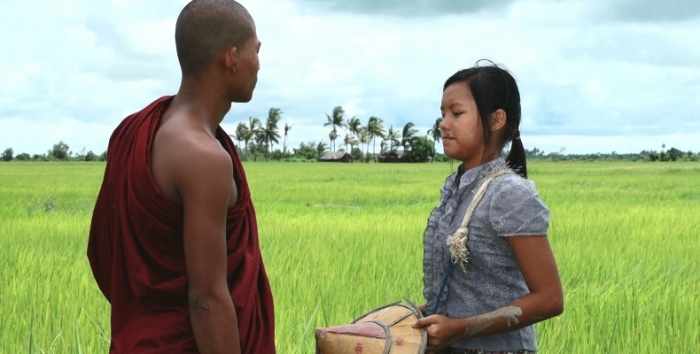You may have thought Borat was the only person making films coming out of Kazakhstan, however, Asia House Film Festival, now in its eighth year, has been showcasing films throughout the week, from Asia and Georgia to Japan, Korea, and Kazakhstan. We went along to experience insights into contemporary Asian culture in these unique portrayals of people’s lives, with this factual documentary style of storytelling. The festival raises issues on spirituality, environmentalism, social infrastructure, progress and the geo-economics of an expanding world.
The first short, Panchagavya was directed by Hana Kitasei (India) and depicts the symbolism of the cow for people in India. Shriya Pilgaonka interviews people from Bikaner in Rajasthan to find out what the cow means to them. The cow is a maternal symbol of the earth and brings good fortune, a reminder of the sacred in everyday life; “nothing is greater than the mother cow… she is beautiful and pure and holy.” If you live on the cow’s produce for five days: milk, clarified butter, sour milk, the urine, and dung, you can reach Panchagavya (purification).
Beautifully filmed with an actuality of everyday scenes and traditional Indian music that fits nicely with the images of the cows going about their daily lives in Bikaner. An enchanting glimpse into the life of a cow in Rajasthan, revered and worshiped, encompassing a practice of gratitude in everyday life. This reaches a stark dichotomy at the end of its life, as the cow deteriorates, all that is left are the carrier bags that were ingested from the streets, as they grazed through the garbage.
The Monk is the story of a Burmese monk, Directed by Maw Naing (Myanmar-Czech Republic), he cares for his elderly superior monk who adopted him as a child. They eventually pawn an electricity generator in return for medical expenses to get to the town of Yangon. You journey with the young Burmese monk as he encounters desires of the material world, including the girl he loves.
At the end of the film we are presented with a scene, which is more of an art installation, the monks sit and meditate peacefully behind their veils, leaving us with an image of pure serenity for a few moments. This awesome stillness is reminiscent of famous mediation experiments worldwide: The TM group in Washington DC that influenced the fall of crime by 23.3% in June 1993. Or Dr. Masaru Emoto’s water crystal experiments where the dynamics of the water are altered via thoughts and words.
The film is reminiscent of the Storyville documentary, The Himalayan Boy and the TV Set; (2014) the western world reaches a community in the mountains with a sudden supply of electricity to their remote village. Following The Monk, you are left with a sense of purity about his world versus modern culture. Whilst he looks outside to the outer world, we look into his world, knowing he has something, a certain clarity that is captured in this naturalistic style of filming.
Mina Walking is a sensitively filmed and provocative, a feature shot in a documentary style and directed by Yosef Baraki (Afghanistan- Canada). Fast cuts and swift camera movements, creating energy and tension in different situations, the actors often improvise scenes to add to this neo-realist style. This is a portrait of an industrious and courageous girl from Kabul who fights to change her life against the odds. Finally, her father aims to sell her to another man and she runs away, almost as if by a career choice to take her life to the streets, we are left with a scene of a man, in the back of a taxi, teaching the tricks of begging.
The film is heartbreaking as you watch this industrious girl, disappointed at every turn, at the same time you get the feeling that the film lacks in a positive message. It seems like it should be acceptable, like the choice to go begging was the right thing to do, or that her father selling her in exchange for some jewellery was perfectly normal. You don’t get the feeling that her, her father or grandfather had any help from the wider community, with a lack of infrastructure and assistance from the outside, in this war-torn country.
While you get the feeling that Mina’s everyday life can be reflected in the Western world, with similar social issues, in the Chinese film Factory Boss, (Da Gong Lao Ban, Zhang Wei) is hard hitting, illustrating factory conditions, where the impact of big corporations is implied, cutting costs and unrealistic targets on suppliers resulting in impossible circumstances.
Insights into different Asian cultures project the embodiment of the ancient with the modern. Marc Johnson’s short YúYú (2014) illustrates this magnificently, as Shé Zuǒ Bīn stands, surrounded by the Yangtze Valley, where he performs the rite of spring, to recover its environmental balance. In this ascetic act, the bees swarm around his whole body as they eventually form a man sculpture of bees. In this art piece, the bees represent the ancient, whilst they have somehow created man, here in the present raising awareness on bees in crisis worldwide. ‘State of Play’, directed by Steven Dhoedt (South Korea), is a documentary filmed in the style of a feature film, embracing and fun from the beginning, as the futurism of the gamers is contrasted by the visits to the house of their ancestors.
Asia House Film festival was a welcome excursion from everyday life, like wearing a different pair of eyes; a refreshing new perspective is offered, whilst thought-provoking and entertaining at the same time as introducing us to people’s everyday life in far-flung regions.




